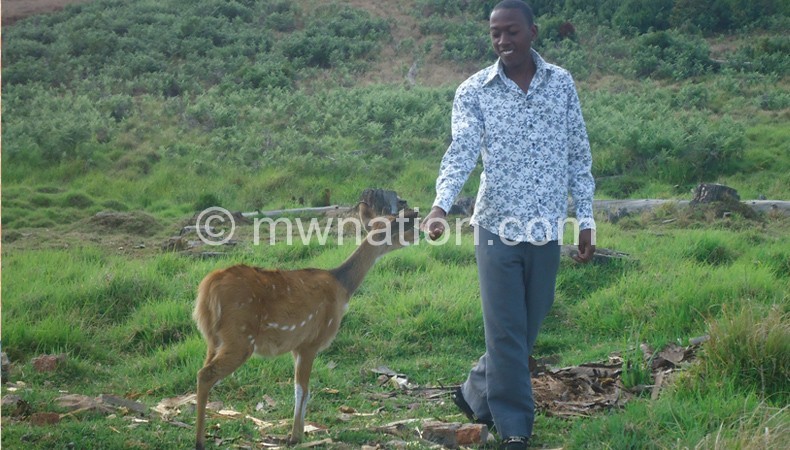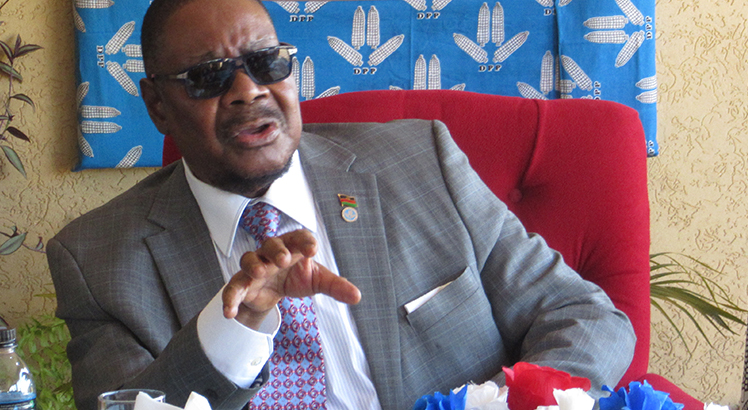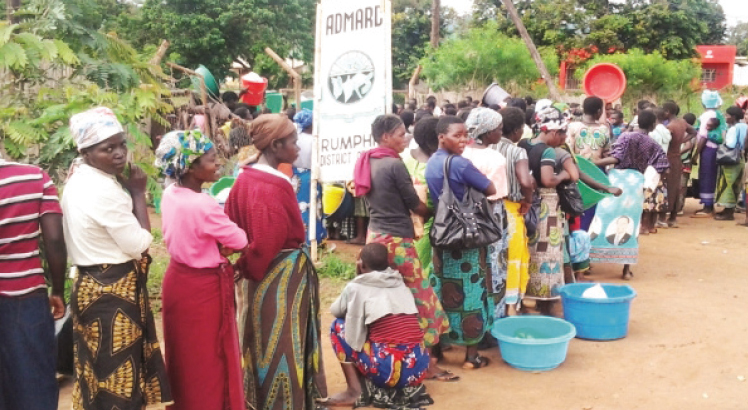Nyika: Hard-to-reach paradise
Nyika is paradise. But it is far and the 120km road from Rumphi is bumpy. Our Mzuzu Bureau Supervisor JAMES CHAVULA writes.
For travellers clamouring for postcard views, Nyika National Park is simply out of this world. In their writings, they call the country’s largest national park a wide range of names from “heaven on earth” and “paradise in the jungle” to “a neglected treasure”.

In the park, it is clear why this is a befitting homage to the scenic savannah setting where human beings wake up to rare sights of game grazing in their backyard and adventurers get to hand-feed bushbucks, antelopes and duikers. The national park, straddling Malawi and Zambia, is endowed with picturesque woodlands and grasslands teeming with herds of animals, such as elephants, zebras, bushbucks, roan antelopes, duikers, hyenas and over 400 species of birds.
There is, however, a sign of worsening neglect that not only makes travellers’ reviews a sour reading but also diminishes the park’s potential to attract tourists and jump-start government’s dream of making the feel-good industry a major source of foreign exchange in the wake of global opposition to tobacco.
The rough road!
The rutted terrain that stretches for 125km between Rumphi and Nyika’s prime lodging spot—Chelinda Camp—has not escaped the searching sight of Lonely Planet, the CNN travel magazine which rated Malawi number three in the world’s top 10 places to visit.
As a matter of fact, the rugged surface is the first thing that catches the eye in the publication’s review of the tourism attraction and could be the reason tourists trek to Tanzania, Kenya, Zimbabwe and Zambia which are putting greater investment in the industry.
First impressions not only matter; they last
Out of 11 people who visited Chelinda camp and cared to share their experience on tripadvisor.co.uk, seven found the tales of their adventures incomplete without mentioning the back-breaking problems the rugged road presents.
In May 2013, a tourist from Mumbai wrote: “The road to the national park is really bumpy, very bad when we visited.”
Nothing has changed at what the visitor aptly termed “heaven on earth.” Even though another visitor from Warwickshire, England, found her stint at Nyika “absolutely amazing”, her account in September 2013 warned: “The road is a mix of sand and stones, so you need to take your time.”
The irony, however, is that time is one of those luxuries the government has in abundance if its reluctance to upgrade the road is anything to go by. The 60km stretch from Rumphi to Chilinda requires 4×4 vehicles specially made for a tough terrain and it takes an agonising 2 hours.
Time is one of the depressing things lost on the road that government does not want to upgrade soon. The road from Rumphi to Chilinda requires 4×4 vehicles specially made for tough terrain and it takes an agonising two hours.
“If you want remote, this is remote,” writes adventure-seeker John Graham. Even Londoner David270 talks about the magical setting of Chelinda “at the end of a 125km rough road from Rumphi”.
Nyika, with its numerous bird’s species, is a birding island—a must-go for those keen on the flying beauties. Talking about flying, there is a grass-carpeted airstrip at Nyika which receives one or two air taxis a month. However, the majority travel is by the road, which is challenging at times, especially during the rainy season.
In January, Danny from Arizona, US, found the ride up the plateau “longer than average”. Unfortunately, this is the first thing tourists see on the way to the place Danny’s “paradise nestled in the hills”.
A case of broken promises
Interestingly, Minister of Information, Tourism and Culture Kondwani Nankhumwa toured the national park in November and declared: “From what I have seen, Nyika meets the tag as paradise on earth, but the road is still bad and this is one of the challenges I would love to be addressed.”
Sadly, the minister knows the ‘bad road’ the locals want tarred is a damning symbol of how political rhetoric and neglect have failed to ease access to the stunning natural wildlife reserve.
“The need to invest in the road is a song that has been sung for a long time. Governments come and go, they sing it and bow out, but they leave the vital road in the same pitiful state,” says the minister, pledging to take it upon himself to champion the quick upgrade of the Rumphi-Nyika Road in Cabinet.
“I appreciate what Nyika means to the country’s tourism potential and will see to it that we put in place a better road,” said Nankhumwa.
But the end of the age-old problem has not yet begun. To locals in Rumphi West and beyond, his is just another promise — like many others before.
Actually, it brings to mind how his predecessor Moses Kunkuyu stepped in Rumphi and promised to ensure relevant authorities resolve the major challenge that impinges on tourist traffic to both Vwaza Game Reserve and Nyika.
At that time, Vwaza-Nyika Association president Chifipa Gondwe told the minister what he was supposed to know the day he got to work: “Improving the road network is a must.”
Kunkuyu might have promised “to pursue the appeal with relevant ministries”, but the hollowness of the promise is clear in the fact that the Roads Authority has not even conducted a survey to ascertain the benefits and environmental impact of the upgrade.
Part of the road accounts for almost 50km section of the Rumphi-Hewe earth road which Rumphi West Member of Parliament, Netherlands-born Jacqueline Kouwenhoven, promised to tar with funding from her benefactors.
On the campaign trail for last year’s parliamentary polls, she promised her prospective constituents that had already identified donors to construct a tarmac from Bumba at Rumphi Boma to Hewe.
But the road remains a tale of false promises, with no sight of graders, excavators and bulldozers on site nine months since Kouwenhoven won the way to the legislature in May 2014.
If the promises were fulfilled, upgrading the road would also open up Nthalire, Wenya and other parts of Chitipa to the rest of the country.
A district apart
Residents of the remote parts of the border district have to surmount daunting transport problems when they travel to Rumphi to procure manufactured goods for business and home use. Sometimes they spend two to three days stuck on the rugged road, a drawback which has left the stretch with fewer vehicles for public transport and the prices of goods spiralling out of reach.
Traditional Authority Nthalire is petitioning the government to declare Nthalire and surrounding areas in Chitipa South West a standalone district. Key to his dream is the completion of Nthalire Rural Growth Centre.
In their minds, the brains behind the rural growth centre envisaged a network of tarred roads, a community hall, a rural stadium, modern market, bus depot and tapped water spurring the transformation of what was once a bushy trading centre into the heart of buzzing business and rural development.
The emerging town is not yet the hive of economic activity it was envisioned to become and TA Nthalire feels confining tarmacs to the heart of the trading centre has only turned the modern rural growth centre into an “island in the bush”.
“We need two things to achieve the development we need,” said the traditional leader in an interview.
“First, split Nthalire from Chitipa just as Likoma was declared a separate district from Nkhata-Bay. Making it a standalone district will save the people of Nthalire and their neighbours the pain of continued dependence on Chitipa District Council which takes years to respond to our development needs.
“Second, there is need for proper roads linking the newly constructed town with Chitipa and Rumphi. When you step on the tarmacs of Nthalire just ask yourself: ‘How did I get here?’ The first pictures that come to your mind are the narrow, bumpy roads that become impassably muddy during the rainy season.”
These are the roads businesspeople endure and the one connecting Rumphi via Nyika is the shortest of them all.
When asked about the long wait for a better road to open up Nyika National Park and surrounding communities, Minister of Transport Francis Kasaila said: “We are aware of the importance of the road that passes through Nyika, but the main problem is that the distance between Rumphi Boma and Chitipa is well over 200km.
“Finding donors to support government to do feasibility studies is a big challenge. So far, only the Kuwait Fund has shown interest to bankroll part of the studies.”
The cost-benefit analysis is supposed to be the first step towards any project the size of the desired road upgrade.
In this regard, Kasaila’s statement does not only confirm how hugely donor-dependent the country has become but also that there is no work done despite all the talk and political rhetoric surrounding the project.
The sight of locals and tourists struggling with vehicles stuck in mud or breakdowns on the earth road is a potent symbolism of how the wheels of government bureaucracy are turning: all promise but are stuck in the mud too.
Still, the tourists we encountered on the rough ride to Chelinda Camp, a prime lodging spot in Nyika, echo the locals’ call for better access to nature reserves.
Sadly, the minister says: “Upgrading the stretch from Rumphi to Nyika is okay, but may not help the people of Chitipa. That is why we are looking at the whole stretch.”
Faced with the stark realities of this expensive approach, said Kasaila, the government is also weighing two alternatives.
“The first option is to do it in phases and the second is to find an investor who can invest in the road and get a concession to run the national park,” he said.
But the road throughNyika is a time-honoured manifestation that endless talk, promises and politics will never be an answer to the development woes besetting the country.





